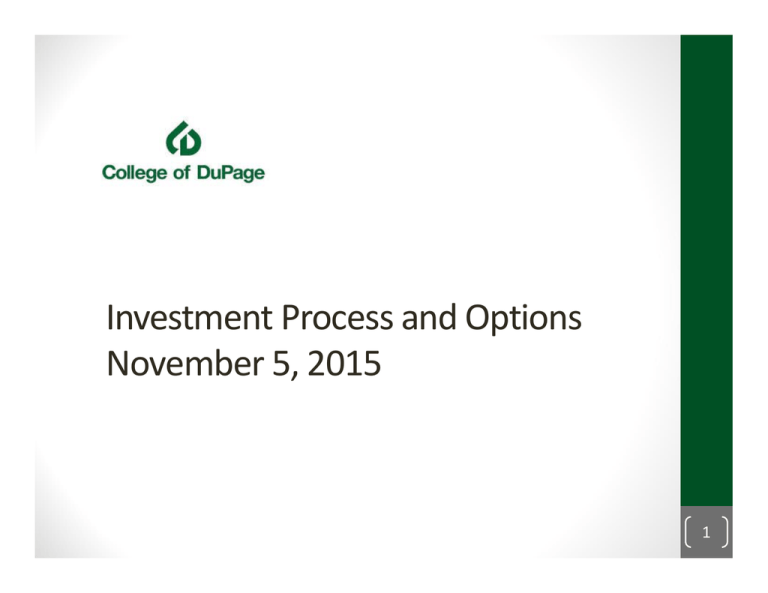Investment Process and Options November 5, 2015 1
advertisement

Investment Process and Options November 5, 2015 1 CODInvestmentManagementConsiderations • Compliance, asset selection and reporting are critical success factors • Benchmark, monitor and compare • More “buy and hold” with adjustments vs. trading • Peer practice: Use qualified advisors instead of “do‐it‐ yourself” • Sources: CFOs, Treasurers or Directors of Investments from University of Illinois College of Lake County McHenry County College City Colleges of Chicago Harper College and Carnegie Mellon University over $3.0 billion cash/investments (‘14) over $160 million (‘14) approx. $40 million (‘14) approx. $195 million (‘15) over $240 million (‘15) over $1.8 billion (‘14) • Above schools make extensive use of advisors on either discretionary or non discretionary basis 2 Optionone:Continued“Self”Management Pro’s: 1. Control our own destiny 2. Familiar 3. Responsive Con’s: 1. Beyond COD’s current abilities / salaries of permanent staff 2. Public confidence lost due to recent performance 3. Expensive to replicate research / compliance tools of major firm 4. Possible increased risk of “drift” vs. benchmark vs. advisor with rigorous compliance infrastructure 3 Optiontwo:“Outsource”LargePortionto HighQualityAdvisors Pro’s 1. With right partners—consistency of research, asset selection, reporting and compliance 2. Still guide process through selecting benchmarks (and monitoring) 3. Saves scarce resources by avoiding hires/expenditures 4. Puts senior financial functions within COD’s ability to pay and focuses more attention on accounting/controls/operations Con’s 1. Unfamiliarity (although concept not entirely foreign—we are using two advisors today for a little under 1/3 of portfolio) 2. Still have demanding oversight responsibility 3. May still require upgrade/addition of staff 4 Recommendations • Divide COD portfolio: Tier 1: Capital needed within 12 months Tier 2: All other capital • Select providers for both tiers • For example: One provider for Tier 1 and two for Tier 2 • COD runs 0 – 90 day balances to operate college • Tier 1 provider orients to compliant short‐term (e.g.— commercial paper) vehicles, funds COD 60‐90 balance • Tier 2 providers each manage $70mm‐$100 mm +/‐ • COD reviews all providers on success and adherence • Goals: more consistent compliance, reporting, performance, avoid internal staffing build (leverage someone else’s infrastructure) 5 OtherObservations • COD has $90 MM in separate managed portfolios advised by PFM and Great Lakes combined. (See Appendix A) • COD portfolio totaled $296mm at Sept. month end • Expect fees between 0.08% and 0.14% per year, or $160,000 to $280,000 on a $200 MM portfolio—if we stay with status quo we would surely spend significant portion on upgrades • Tier 2, at $200 million level, should enable COD to access diversified portfolio of compliant securities or funds in a cost efficient way • Today COD receives limited investment strategy on overall portfolio or compliance regime • Mandate to steward and grow funds to achieve educational mission 6 InviteTopInvestmentAdvisors • Going to market with RFP. Noticing up in press, relevant and affordable websites. • COD will have proposals within 30 days • Select with goal of recommendation to board some four to six weeks after initial RFP noticing. • DRAFT RFP already has more than 25 questions in four categories: 1. 2. 3. 4. Structure and experience of firm Compliance regime with Board policy and statute Proposed portfolio structure, monitoring and performance Fees 7 Conclusions • As was discussed in August presentation and evidenced by Internal Audit report: Self‐management of portfolio severely stressed COD finance department’s capabilities • • • • Compliance was haphazard Reporting and record keeping was deficient Documentation was missing Performance was sub‐par, shown especially with IMET loss • COD should bring in qualified money managers and orient them toward • • • • Compliance with Illinois Funds Act and COD Policy Appropriate benchmark/reporting Results Mission 8 Appendix A: Performance of Current Managers • Currently the college has two advisors that manage portfolios: PFM and Great Lakes. PFM has been in place since 2009, and Great Lakes since Nov. 2014 PFM (1‐3 Year Mostly Gov’t) PFM (Comm. Paper) BAML 1‐3 Year Treasury Index Great Lakes (Muni Bonds) $26.0 MM $20.0 MM N/A $45.2 MM Latest 12 Months Returns* 1.11% N/A (too new) 1.16% N/A (too new) Return since inception** 0.76% N/A (too new) 0.63% since PFM inception 0.89% 1.5 <1 year 1‐3 years <1.6 years Size Duration *LTM returns are net of fees. PFM Commercial Paper portfolio established in August. Current yield to maturity estimated at 0.61%. **Net return defined as net of fees and annualized. 9


